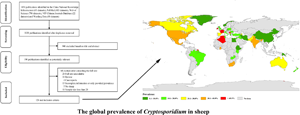Crossref Citations
This article has been cited by the following publications. This list is generated based on data provided by
Crossref.
Dărăbuș, Gheorghe
Lupu, Maria Alina
Mederle, Narcisa
Dărăbuș, Rodica Georgiana
Imre, Kalman
Mederle, Ovidiu
Imre, Mirela
Paduraru, Ana Alexandra
Morariu, Sorin
and
Olariu, Tudor Rares
2023.
Epidemiology of Cryptosporidium Infection in Romania: A Review.
Microorganisms,
Vol. 11,
Issue. 7,
p.
1793.
Holsback, Luciane
Marquez, Ellen de Souza
Silva, Marcelo Alves da
Porto, Petrônio Pinheiro
Garcia, João Luis
Martins, Felippe Danyel Cardoso
and
Seixas, Mércia de
2023.
Molecular characterization of Cryptosporidium in ruminants and observation of natural infection by Cryptosporidium andersoni in sheep from Paraná, Brazil.
Revista Brasileira de Parasitologia Veterinária,
Vol. 32,
Issue. 4,
Wang, Zhengrong
Peng, Xia
Bo, Xinwen
Zhang, Bowen
Zhang, Yanyan
Yu, Fuchang
Zhao, Aiyun
Zhang, Zhenjie
and
Qi, Meng
2023.
Molecular evaluation of Cryptosporidium spp. in sheep in southern Xinjiang, China.
Parasitology Research,
Vol. 122,
Issue. 12,
p.
2989.
Tako, Sivan
Fleiderovitz, Ludmila
Markovich, Michal Perry
Mazuz, Monica Leszkowicz
Behar, Adi
and
Yasur-Landau, Daniel
2023.
Cryptosporidium parvum gp60 subtypes in diarrheic lambs and goat kids from Israel.
Parasitology Research,
Vol. 122,
Issue. 9,
p.
2237.
Mirahadi, Seyed Nima
and
Moghaddasi, Kambiz
2024.
Cryptosporidiosis as One Health Issue in Iran: A Mini Review.
International Journal of Enteric Pathogens,
Vol. 12,
Issue. 1,
p.
47.
Mwaba, Florence
Robertson, Lucy J.
Tembo, Rabecca
Zulu, Mildred
Ngalamika, Owen
Phiri, Andrew M.
and
Siwila, Joyce
2024.
Occurrence and factors associated with Cryptosporidium infection in livestock in three districts of Zambia.
Veterinary Parasitology: Regional Studies and Reports,
Vol. 52,
Issue. ,
p.
101057.
Li, Jiayu
Fan, Yingying
Li, Na
Guo, Yaqiong
Wang, Weijian
Feng, Kangli
He, Wei
Li, Falei
Huang, Jianbo
Xu, Yanhua
Xiao, Lihua
and
Feng, Yaoyu
2024.
Comparative genomics analysis reveals sequence characteristics potentially related to host preference in Cryptosporidium xiaoi.
International Journal for Parasitology,
Vol. 54,
Issue. 7,
p.
379.
Zhao, Qianming
Qi, Meng
Jing, Bo
Jian, Fuchun
Gong, Pihong
Lu, Chenyang
Yan, Yaqun
Pei, Zhiyang
and
Ning, Changshen
2024.
Cryptosporidium spp. in large-scale sheep farms in China: prevalence and genetic diversity.
Scientific Reports,
Vol. 14,
Issue. 1,
Cheng, Cheng
Fan, Zhengrong
Cheng, Darong
and
Tao, Jianping
2024.
Prevalence of Cryptosporidium spp. in Sheep and Goats in Jiangsu, China.
Veterinary Sciences,
Vol. 11,
Issue. 4,
p.
144.
Aboelsoued, Dina
Toaleb, Nagwa I.
and
Abdel Megeed, Kadria N.
2025.
Coproantigen detection and molecular identification of Cryptosporidium species among newborn and adult farm animals.
AMB Express,
Vol. 15,
Issue. 1,
Peng, Xiaoxue
Wang, Xu
Jian, Jinhua
Zuo, Qingqiu
Liu, Hua
Wang, Yaxue
Su, Yaxin
Cao, Jianping
Jiang, Bin
and
Shen, Yujuan
2025.
Investigation of Cryptosporidium spp. and Enterocytozoon bieneusi in free-ranged livestock on the southeastern Qinghai–Xizang Plateau, China.
BMC Infectious Diseases,
Vol. 25,
Issue. 1,
